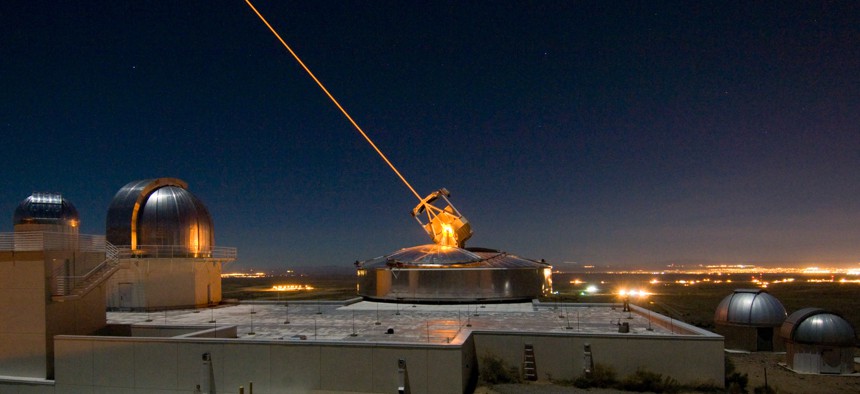
David Vergun/U.S. Army
Get Lasers Into the Field Faster, Lawmakers Tell the Pentagon
The Senate’s version of the annual defense bill provides $200 million for rapid prototyping of directed energy weapons.
There’s no shortage of U.S. military interest in battlefield lasers and other directed-energy weapons. From truck-mounted lasers to high-powered microwaves that take down small drones , the Army, Navy, and Air Force are all exploring the possibilities. But congressional leaders say for all that interest, the technology’s not getting into the field fast enough.
Take the electronics-frying missile CHAMP, Counter-electronics High Power Microwave Advanced Missile Project : Developed by the Air Force Research Laboratory in conjunction with Boeing, and successfully flight-tested in 2012, the missile isn’t being fielded by any of the services. Neither is Raytheon’s smaller ground-based derivative, which took out two small drones by disabling their electronic systems in a 2013 demonstration.
A number of technologies like that need to be pushed over the final hurdle: out of the lab and onto the battlefield, said Sen. Martin Heinrich, D-N.M.
“It is not happening quick enough,” says Heinrich, the ranking member on the Senate Armed Services Subcommittee on Emerging Threats and Capabilities. “And I think we’ve had a culture of simply always chasing the perfect technology instead of saying, ‘A lot of this stuff is ready for primetime now, and there’s a use for it in the field we need to meet now.’”
Heinrich helped secure $200 million in the Senate’s version of this year’s defense authorization to quickly iterate and demonstrate directed energy weapons. The initiative would be housed under the Assistant Secretary of Defense for Research & Engineering. The provision — not included in the House’s version of the bill — still needs to make it through a conference with the other chamber, but communicates the Senate committee’s belief that “directed energy can fundamentally change warfare, much like precision-guided weapons did.”
The House’s version does note, multiple times, its support for directed energy weapons and “encourages the Department of Defense to make greater efforts to utilize these technologies where appropriate.” It also provides its own plus-up for directed energy, but that $55 million goes to prioritizing the technology in ballistic missile defense.
Last decade, the Pentagon explored the possibility of using lasers to shoot down nuclear missiles during their boost phase with the expensive Airborne Laser project, and is interested in the idea again . The problem with that, said Theresa Hitchens, a researcher at the Center for International & Security Studies at Maryland, is that the physics of the situation make it difficult to complete cost-effectively and reliably.
"It’s limited in the ground, in the coverage it can provide," Hitchens said. "It has a very window to operate in, and the timing to be able to discriminate, it’s just not possible for humans ... It would have to be an automated system that would fire. Is that what you want?"
Though the $200 million the Senate bill provides could be used to prototype various directed energy weapons at the assistant secretary’s discretion, it highlights several “specific missions in which directed energy could provide solutions to capability gaps,” including fighting off UAVs, rockets, artillery, and mortars.
“We’ve done a lot of microwave work on the side of being able to send in a cruise missile that knocks out electronics,” Heinrich said. “That is just as important as the counter-UAV mission. Both of them are pretty critical at the moment.”
The Defense Advanced Research Projects Agency and other labs are making moves to test directed energy weapons to tackle these solutions. DARPA just announced a competition to demonstrate systems that could take down swarms of drones a kilometer away.




